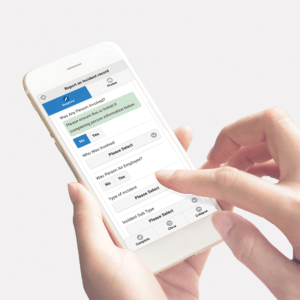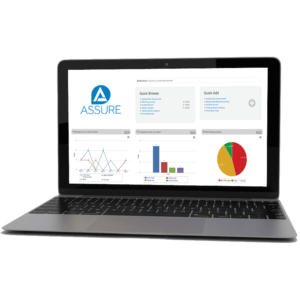SHP speaks to Matthew Elson, CEO at SHE Software, about how its Assure system is ‘changing the way companies manage health and safety’.
Founded in 1995 and headquartered in Scotland, SHE Software is an expert in the application of technology to solve its customers’ health and safety challenges. Located across the UK, US and New Zealand, its experienced team are IOSH or NEBOSH accredited, helping them to understand customer needs and speak their language.
 Matthew Elson took over as CEO in 2014, having acquired the firm in 2011, bringing with him a wealth of executive experience leading both large and small businesses. He heads up the development of the business, across the UK, US and New Zealand.
Matthew Elson took over as CEO in 2014, having acquired the firm in 2011, bringing with him a wealth of executive experience leading both large and small businesses. He heads up the development of the business, across the UK, US and New Zealand.
Through its Assure product, SHE Software ‘aims to make health and safety real-time and predictive, allowing any issues or potential hazards to be seen and logged straight away and rectified before any hazards become a fatality.’
According to the Health & Safety Executive’s most recent Labour Force Survey, more than 600,000 workers are injured in the workplace in the UK every year. The average cost to a business is £8,200 for a non-fatal injury, rising to £1.6 million for a fatal injury. For every minor injury or serious incident, there are 3,000 near misses, and for every major injury, there are more than 300,000 at-risk behaviours. Safety incidents are one of the most common reasons that organisations stop production altogether.
Recently launched in the USA, Assure currently has over half a million users worldwide and can be found in over 850 organisations across the globe. Assure addresses the challenges organisations face in recording, tracking, managing and reporting by giving all employees a ‘health and safety voice’, and ensuring health and safety teams can achieve their number one priority – to keep staff safe.
Day-to-day operation
 Talking about the thinking behind the product, Matthew said: “One of the major trends in terms of health and safety software is that health and safety doesn’t happen behind a desk. Therefore, there was a call for technology which gets health and safety into core operations, making it part of the day-to-day operation of organisations. Mobile is an important part of that, which is why we’re focussed on mobile platform.”
Talking about the thinking behind the product, Matthew said: “One of the major trends in terms of health and safety software is that health and safety doesn’t happen behind a desk. Therefore, there was a call for technology which gets health and safety into core operations, making it part of the day-to-day operation of organisations. Mobile is an important part of that, which is why we’re focussed on mobile platform.”
“Organisations want to maximise their reporting of near misses and unsafe acts. The biggest barrier to reporting is not having an easy, low impact means for front-line employees to do this. By making sure that, when something is recorded, there is an immediate message through to the supervisor, users can feel more confident the issue that they report is going to be addressed. People are more likely to report something if they know they will hear back about what happens, embedding safety culture into the day-to-day running of a business.”
International fresh produce company,G’s, enlisted SHE Software’s help in 2014, in part, to tackle this very issue. G’s is a globally diverse group of farming, fresh produce and chilled foods companies. From a small field in 1952 to an international business, G’s supplies products to major supermarkets across the UK and Europe, and employs 7,000 staff, contractors and seasonal workers.
Head of Health, Safety, Risk and Continuous Improvement, John Boyle, said: “Our ultimate aim is to ensure the safety of all our employees in all areas of our business. Assure has helped to reinforce a positive, inclusive behavioural safety culture with significant increases in the number of near misses reported.”
“We’re using technology in an innovative way to make safety better. SHE Software has changed how we manage our incidents and how involved our people are, moving the involvement lower down to the shop floor.”
Since the introduction of Assure, G’s has seen more than 17,000 behavioural conversations recorded.
Matthew Elson continued: “The attraction of the very short, upfront recording to the supervisor is that we know from experience that long forms put people off. That is why we made the form configurable and responsive: it only asks relevant questions, learning from the answers to previous questions.”
John Boyle introduced SHE Software at G’s with a specific objective in mind: “I wanted to change how we did certain things, which the system has enabled us to do. It’s changed how we manage and where the ownership sits, so a piece of paper is not filled out before disappearing, it has to be followed-up and closed off.
“Aside from the large-scale facilities, we have a lot of workers who work on their own in remote locations and SHE has given us the capability to get real-time information and communication, to report things, follow-up on things, investigate accidents and incidents and manage our safety. It takes away that administrative burden and makes safety easy.”
 With the technology accessible by computer, tablet or smart phone, G’s large number of remote workers are now able to capture health and safety information at any location, regardless of data connection.
With the technology accessible by computer, tablet or smart phone, G’s large number of remote workers are now able to capture health and safety information at any location, regardless of data connection.
More businesses are wanting to take a risk-led approach, rather than a compliance approach. “The challenge is that you are overloaded by the number of risk assessments that need to be done. Our take,” said Matthew, “is you should only formally assess the risks that you need to and use technology to make those risk assessments more practical. Have a template and use technology to create a collaborative approach that engages those in operations who have most knowledge and experience. Then don’t hide them away in a filing cabinet, but make them accessible, for example on a tablet. A great way to do this this is by reading a QR code on a piece of equipment to bring up relevant information.”
Ease of accessibility goes a long way to starting to embed safety culture in an organisation, getting health and safety technology into the hands of front line operators and engraining safety thinking in day-to-day activities. Encouraging, rather than discouraging, front-line staff to carry mobile devices with them has led to the introduction of geofencing technology, which can use GPS to send push notifications, for example to warn operatives when they are approaching or close to hazards.
“Traditionally, you had to know what you were looking for and navigate through a series of menus, or go to the right filing cabinet to find it. Technology provides the potential to push relevant information to the user based on an understanding of their activity, location and skills.” Matthew concluded.
Safety Technology Zone
New for at Safety & Health Expo, 18-20 June at ExCeL London, will be a demonstration some of the ways that technology is changing health and safety – both how tech can be adopted by the profession but also where it poses new risks.
Drones, AI, VR and wearables are just some of the areas you can learn about.
Registration is now open, click below to secure your free place.
